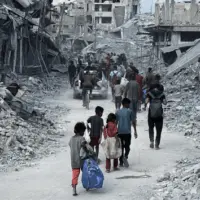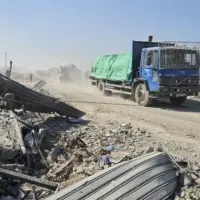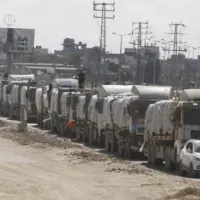
(KHAN YOUNIS, Gaza Strip) — While there was joy on the faces of some Palestinians returning to the Gaza Strip this week after two years of war, many said they found their old neighborhoods unrecognizable from the relentless fighting that reduced many of the buildings to rubble.
Following the historic ceasefire agreement enacted on Monday, tens of thousands of displaced residents and nearly 2,000 Palestinians released from Israeli prisons made it back to Gaza, only to find themselves homeless.
“Of course, I was happy about being released, but not happy of being displaced with no safety in place, no life necessities,” said 23-year-old Abdullah Wa’el Mohammed Farhan, one of the former Palestinian prisoners freed on Monday as part of a ceasefire deal that President Donald Trump helped broker.
Standing outside a tent in Khan Younis, where he and his family are living, Farhan told ABC News that he was imprisoned for 20 months as the war with Israel raged on. He said that while detained, he and the other Palestinian prisoners were “completely isolated from the world.”
“When I was told about my release, I didn’t believe it because more than once [Israeli authorities] told us about our release and moved us from one prison to another while being tortured and beaten,” Farhan said.
ABC News has contacted the Israel Defense Forces and the Israel Prison Service about the allegations from Farhan and other released prisoners about being tortured and subjected to starvation while incarcerated, but have not received a response.
Fahan’s sister, 21-year-old Samaher Farhan, told ABC News that while she is thankful they have been reunited, she conceded that she was saddened her brother had to return to a community wrecked by the war.
“When I saw Abdullah yesterday, it was mixed feelings of happiness and sadness because of how he looked before he went to prison and how he looked now,” Samaher Farhan said.
She said she hopes to resume living in their home, which is still intact but in an area that is not habitable. For the time being, she said her family is living in a tent.
“We felt bad that this is not a worthy welcoming of a prisoner,” Samaher Farhan said. “How can he come out to a worn tent? So, it was a sad feeling. I even tried not to meet him or sit with him for a long time because the situation is dire in this worn tent.”
She said that when her brother was taken prisoner, their neighborhood was still in good shape, adding, “It was barely 1% of the destruction we have now.”
The United Nations and other organizations have reported that there is no safe place in the Gaza Strip, which is about 25 miles long by 7.5 miles wide. The IDF has designated most of the war-torn territory a “no-go zone,” issuing evacuation orders for civilians there, according to the U.N. Office for the Coordination of Humanitarian Affairs.
According to a damage assessment by the U.N. Satellite Centre, 83% of all structures in Gaza City, the capital of the Palestinian territory, are damaged. The assessment identified at least 17,734 structures that have been destroyed, about 43% of the total number of structures damaged.
In a report issued on Tuesday, the U.N. estimated that it will cost around $70 billion to reconstruct Gaza.
In its latest report on Wednesday, the Palestinian Ministry of Health said that nearly 68,000 Palestinians were killed in the Gaza Strip during the war, which started when Hamas terrorists launched a surprise attack on Israel on Oct. 7, 2023, killing more than 1,200 people and taking about 250 others as hostages.
The final 20 living Israeli hostages were released by Hamas on Monday as part of the ceasefire deal.
Shadi Abu Sido, a Palestinian photojournalist who was among those released from an Israeli prison on Monday, said he was shocked by the widespread devastation that has occurred in Gaza since he was detained in March 2024.
“I entered Gaza and found it to be like a scene of Judgment Day,” Sido said in a video testimony. “This is not Gaza. Where is the world?”
He said that while he was in prison, he was told by an Israeli prison officer that his wife and two children had been killed during the war. But once he returned to his home in Khan Younis, he said he learned that was not the case.
“I heard her voice, I heard my children, I was astonished. It cannot be explained, they were alive,” Sido said in an interview with Reuters.
But for another Palestinian prisoner, the euphoria of being freed was quickly replaced by agony when he learned his three children — ages 2, 5 and 8 — had died in the war.
In a video testimony, the man, whose name was not released, is seen falling to his knees and sobbing.
In the video, the man held a bracelet in the palm of his hand and said he had made it in prison and planned to give it to his youngest daughter.
“I made this for my daughter, whose birthday was supposed to be in five days,” he said in the video.
Copyright © 2025, ABC Audio. All rights reserved.














